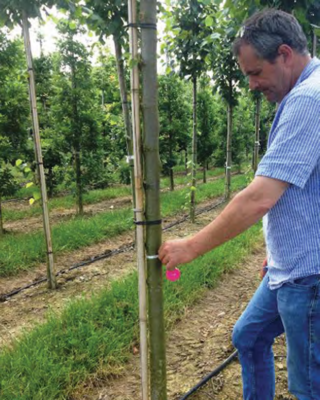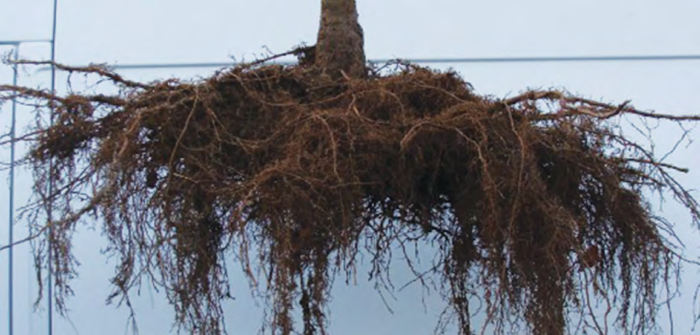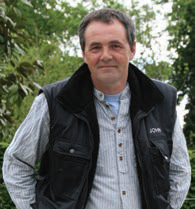In the first of a series of articles, John Murphy, respected nurseryman, and owner of Annaveigh Plants addresses a growing knowledge deficit by getting back to the basics of tree and shrub specification
As a nurseryman involved in the growing and sale of trees from whips to semi mature specimens, I spend a lot of my time dealing with landscape bills of quantities. While many are well written and conform to recognised standards, others are less professional and leave many holes for unscrupulous people to exploit. Examples include where trees are specified by height rather than girth. A 4.5m Betula pendula can be interpreted as anything from a badly grown 8-10cm to a well grown 18-20cm. Another example is where shrubs are specified without a pot size, so inevitably 1.5lt or P9 pots are used. But the biggest problem often lies with the architect or designer not being able to recognise what they are actually specifying. It’s very difficult for someone who is not a grower to see the difference between an x3 transplanted tree and a x2 or between a 1+0 and a 1+1 transplant.
The European Nursery Stock Association (ENA) has a very comprehensive guide to the standards required for international trade and can be accessed through a link at the end of this article.
While we are required by our Bord Bia Quality Assurance Scheme to grow our trees to the standards set out by the ENA, many trees planted in Ireland are unfortunately well below these standards.
UNDERSTANDING TREE CATEGORIES AND MEASUREMENTS
|
HOW TO SPECIFY WHIPS AND TREES
Starting with whips, I would advise against using anything below 40cm, as these young trees tend to be weak and are best lined out in the nursery. Starting with 40-60cm, whips are then specified in 30cm increments: 60-90cm, 90-120cm, 120150cm and so on. All whips used in landscaping work should be 1+1 or heavier, this means a one-year seedling (1+0) has been taken and lined out for a further year at a wider spacing than the seedbed. The root formation on the 1+1 is bushy and very fibrous while that on the younger 1+0 will be just a tap root. In windy, exposed locations I would advise that plants no bigger than 60-90 cm are used as without support larger plants will suffer badly from wind rock, no matter how well planted. If you wish to use a larger transplant then some form of support is advised.
The specification of larger transplants over 150cm can be difficult. It is best to look for a 1+2 or even a 2+2 as these are grown at wide spacing and the plants are furnished to the ground. Specifying a 1+1 at 150cm + tends to end up with a very weak plant with little or no lower branches. Obviously, there will be a cost implication for the cheaper product being supplied.

Moving onto trees we start with 6-8cm girth. The girth is measured – in all cases except olives – by measuring the circumference of the tree 1m from ground level if the tree is planted or 1m from the soil line if the tree is lifted. The root zone is never taken into account when measuring the girth of a tree. Girth increases in increments of 2cm from 6cm up to 20cm. After 20cm, increments of 5cm are used e.g. 20-25cm. After 50cm the increments increase to 10cm e.g. 50-60cm.
All standard trees should have a straight stem with no bends and be free of side branches up to 1.5m for 6-8cm and 1.8m for 8-10cm trees. Smaller trees up to 12cm girth are normally twice transplanted and under normal growing circumstances have a good root system for this size. Trees above 12cm should be specified as 3 times transplanted (x3) as they perform better at transplanting and should have a bigger crown than 2 times transplanted trees. Planting 2 times transplanted trees above this size will normally lead to failures. All 3 times transplanted trees should have a stem height of 2m with a balanced crown.
When using 20-25cm up to 3035cm, the trees need to specified as 4 times transplanted. This is often hard to find in Ireland as many of the bigger trees are only 3 times transplanted at best and tend to leaf out and sit for a considerable time before increasing in girth and crown size. Between 35 and 50cm trees should be 5 times transplanted at least and above 60cm all trees should be 6 times transplanted. In our case, if we are supplying very large specimens we tend to try and source x7-x8 times transplanted trees. While doing this we tend to price ourselves out of projects but we will only get involved if the correct trees are used. Replacing these very large specimens and having disappointed clients is not worth the extra money made by skimping on the product in the first place.

When specifying trees it is important to include whether the trees should be standards or feathered trees. Often it is presumed that Quercus, Betula, Carpinus and Alnus are all to be supplied feathered once they appear on a specification. These trees are far easier to grow branched and the quality is normally inferior to the standard product. What often happens is they are delivered branched and cleaned up on site, and as a result, they leave an unbalanced crown relative to the stem and unsightly pruning cuts on the stems.
If feathered trees are required, it is better to specify them by height with a minimum girth. For example, if a client requires 4m feathered Betula the minimum girth should be 12-14cm otherwise it is quite possible you will end up with whippy 8-10cm trees that have been grown too close together. In the case of specimen feathered trees such as Quercus ‘Fastigiata Koster,’ the same applies, height with a minimum girth. The difficulty here is the fullness of the trees and I would advise that photographs are received prior to delivery to ensure the right quality is supplied.

TO ROOTBALL OR NOT TO ROOTBALL
A well grown bare root tree, one that is delivered with no soil on the roots, should be at least x3 transplanted if it is going to be used on a general landscape site. Many architects have started to specify smaller and smaller trees rootballed and I think this is as a result of a fear of failure. If a well grown x3 tree is used bareroot and adequately watered then there is no reason to rootball as it’s a waste of soil and transport. To rootball and transport a tree it costs an extra €20 for anything above 14-16cm.
“Many architects have started to specify smaller and smaller trees rootballed and I think this is as a result of a fear of failure ”
Every season we are requested to price for rootballed trees that do not require rootballing. Examples would be Sorbus aucuparia and Acer platanoides types up to 16-18cm. If the trees are coming from a proper transplanting regime then almost all the main species with the exception of oak and Fagus will transplant perfectly barerooted up to 18cm. We are wasting soil and fossil fuels unnecessarily rootballing thousands of trees each year all because people are unaware of what an x3 or x4 times transplanted root system should look like.
I would urge everyone involved in specifications to visit tree nurseries and become familiar with what an x2, x3 or x 4 transplanted trees look like. All nurserymen would be delighted to show you around and give the information required. I would advise you to visit a number of nurseries and see the difference in spacing, transplanting, pruning and general care. It will soon become apparent which nurseries are following the correct husbandry techniques and growing the trees to a proper standard. www.enaplants.eu/EXEN/assets/ ENAQualityStandardsFinal2010.pdf ✽
 John Murphy is the owner and operator of Annaveigh Plants and is one of Ireland’s most experienced and respected nurserymen. John Murphy is the owner and operator of Annaveigh Plants and is one of Ireland’s most experienced and respected nurserymen.
For more information visit www.annaveigh.com |






